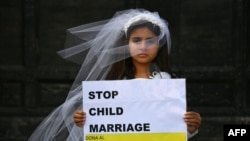A prominent member of the Islamic Republic's Cultural and Social Council for Women is defending child marriage, arguing it protects girls from a life of prostitution and illegal abortions.
Fereshteh Rouhafza said told ILNA in an interview published on December 4, that in light of the rapidly growing number of increasingly young girls undergoing illegal abortions and joining the sex trade, “opposition to child marriage is wrong.”
Rouhafza, who is in charge of planning and policy making for the council, declined to provide evidence of her claims about Iran’s young women, saying the statistics are available, but it would be irresponsible to make them public.
"Publishing the statistics will encourage other underage girls to follow suit. I believe revealing such statistics is harmful to society,” Rouhafza said.
Though Rouhafza supports child marriage, she is a staunch opponent of integrating boys and girls in school. It is their contact outside of marriage that leads girls down the path to prostitution and illegal abortions, she says.
“When thirteen-year-old girls become familiar with sexual affairs, they will definitely seek sexual relations with their opposite gender,” Rouhafza warned, adding, "Girls of thirteen, if informed about sex, long for the opposite gender and sexual intercourse."
Moreover, Rouhafza believes that Iranian public life is over-sexualized, and has accused even Iranian state media of excessive sexualization, citing a recent program she says dealt explicitly with masturbation.
An unbending proponent of compulsory hijab (Islamic head covering), Rohafza’s comments reflect the position of the conservative clerical establishment on child marriage. Insisting that the Prophet Muhammad is the perfect example of all Muslims, they note that he married a six-year-old bride, Aisha, with whom he consummated the marriage when she was only nine years old.
Although little data is available on child marriage in Iran, UNICEF estimates that approximately 17 percent of girls there are married before the age of 18. The numbers may be even higher, as many families in Iran do not register births or underage marriages.
According to Iran’s Association of Children’s Rights, the number of girls married in Iran under the age of 15 went from 33,383 in 2006 to 43,459 in 2009, a 30 percent increase in three years. Experts say the increase is due to deepening poverty and parents’ desire to control their daughter’s sexuality.
According to the Islamic Republic’s civil code, the legal age of marriage in Iran is thirteen for girls and fifteen for boys. However, the civil code allows girls as young as nine to marry with the consent of their father or the permission of a court judge.
Nevertheless, according to Tehran's pro-reform MP, Ms. Fatemeh Zolghadr, "Despite the opposition of several Grand Ayatollahs, a parliamentary motion for raising the legal age of marriage has not been shelved.”
The women’s faction in parliament hopes to pass the motion, Zolghadr said, thereby increasing the legal age of marriage to at least 15 or 16 years for girls.
The government's official news agency (IRNA) cited the director-general of cultural studies at the parliament's research center December 4 as saying, "Nearly 4,000 underage marriages are registered every year in Iran.”
Two years ago, a U.N. panel warned of a rising number of young girls forced into marriage in the country, calling on Iran to change the current laws allowing girls as young as 9 to wed.
The U.N. Committee on the Rights of the Child (CRC) said that Tehran must “repeal all provisions that authorize, condone, or lead to child sexual abuse” and called for the age of sexual consent to be increased from nine years old to 16.
The panel said that Iran “allows sexual intercourse with girls as young as nine lunar years and that other forms of sexual abuse of even young children is not criminalized.”
The CRC added that an increasing number of “girls at the age of 10 years or younger... are subjected to child and forced marriages to much older men” and criticized a law that makes it necessary for wives “to fulfill sexual needs of their husbands at all times,” stressing that it “places child brides at risk of sexual violence, including marital rape.”





